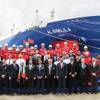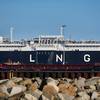The Panama Canal welcomed the inaugural transit of the LNG Sakura as it carried the first-ever liquefied natural gas (LNG) shipment from the Dominion Cove Point terminal in the United States to Japan.
The transit, which occurred this past weekend, marks the beginning of a new LNG commercial route between the United States and Asia from the recently inaugurated Dominion Cove Point terminal in Maryland, the second U.S. LNG export terminal to come online after Sabine Pass began operations in 2016.
Dominion Cove Point has two main clients: ST Cove Point, a consortium consisting of Sumitomo Corporation and Tokyo Gas; and Gail Global LNG, a subsidiary of GAIL LTD of India. The LNG Sakura carries the first shipment of the 0.8 million tons of LNG contracted per year by the Japanese energy company Kansai Electric.
The Bahamas-flagged LNG Sakura is a Neopanamax vessel, measuring 300 meters in length and 49 meters in beam. Its transit on Saturday began in the Agua Clara locks on Panama's Atlantic side and headed towards the Cocolí locks in the Pacific.
Kansai Electric Power is the majority share owner of the LNG Sakura (70 percent); NYK Line owns the remaining stake.
The Panama Canal has emerged as an important link in the global LNG supply chain ever since the Inauguration of its Expanded Canal in 2016, when the waterway first began transiting LNG vessels.
Today, the capacity the Canal offers to LNG shippers exceeds the existing demand: the Panama Canal currently provides seven booking slots to LNG shippers per week - who average 5.5 transits during the same period - and has proven its ability to handle more transits when needed during uncharacteristically high periods of use. On April 17, for example, the Canal transited three LNG vessels in one day, representing a first for the waterway.
In FY 2018, the Canal's LNG traffic is expected to grow by 50 percent compared to FY 2017, increasing from 163 to approximately 244 transits, for which the Panama Canal stands ready to receive. The Canal has worked closely with industry partners to communicate its willingness to offer shippers additional capacity, commensurate with demand, as is warranted.
As the global demand for LNG continues to grow, the Panama Canal remains committed to offering an efficient and safe transit that will benefit its customers, reducing travel times and unlocking new opportunities for world trade.










